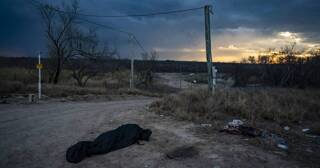EARTH Magazine: Return of the Dust Bowl
Much, much more at link.
Haboobs walloped Arizona last summer. Locals long ago adopted the Arabic word for a major dust storm, but even old-timers say they can’t remember anything quite like this year’s aerial assaults.
One that struck Tucson in July reportedly towered more than 1.6 kilometers in the air, had a 160-kilometer breadth and featured scouring winds of up to 112 kilometers an hour. Phoenix was hit three times, including a haboob in July that topped out at about 1.2 kilometers and stretched 80 kilometers. The massive dust storms knocked out power, grounded flights, caused car accidents and, perhaps most significantly, gave us a glimpse of the potential future of the American West.
Researchers from a variety of disciplines concur on this forecast: Over the next two or three decades, the American West — from West Texas to New Mexico, Arizona, Colorado and on into Southern California, Nevada and Utah — will transition to a climate that may make the 1930s Dust Bowl seem mild and brief.
The grim forecast is no simple extrapolation from climate models. Rising temperatures will contribute directly and indirectly to rising dust, but that is only one of many converging causes, both natural and human. Persistent drought, increasingly violent and variable weather, urban and suburban development, off-road recreational vehicles, and even the installation of large-scale solar energy arrays threaten to shroud the West in dust.
The rise in dust, which includes any solid particle small enough to become an aerosol, can’t be ignored. As last summer’s haboobs demonstrated, great volumes of dust can wreak havoc. Worse yet, the composition of today’s dust — which includes industrial pollutants from as far away as China, heavy metals such as mercury and lead, potentially deadly soot from wildfires and a local pestilence known as Valley Fever — poses a threat to public health.
Dust Rises Up
To understand why the West is headed for a Dust Bowl future, scientists first need to understand dust itself. Dust has always been part of our environment, explains Jason Neff, a geochemist at the University of Colorado at Boulder. It performs valuable ecosystem chores, such as transporting minerals from barren deserts to the oceans, where they support life.
Most of the dust in the West formed through erosion over millions of years in places like the Mojave and Sonoran deserts, and it remained grounded most of the time — until people, with their herds, homes and machines, came along and kicked it up into the atmosphere. Neff says that he and a small band of scholars who study dust had no idea how much influence humans have on the dust “flux” — the volume lofted into the air — until the mid-2000s, when they studied lake sediments in Colorado’s San Juan Mountains, far from any grazing or mining. Through analysis of the sediment composition, they measured the amount of the dust trapped in each annual layer.
What they found was astonishing. From the 1860s to the early 1900s, the dust load of the atmosphere shot up 500 percent. The main reason for the upsurge was cattle. During that period, railcars transported more than 50 million head of cattle to graze out West, Neff says. “Overall, nearly 70 percent of the natural ecosystems of the Western United States have been affected by livestock grazing,” which has resulted in the loss of soil stability and increases in wind erosion of soil, Neff and his colleagues reported in Nature Geoscience in 2008. That, in turn, released great volumes of dust into the atmosphere.
Eventually, the dust settled down again with the passage of the 1934 Taylor Grazing Act, which set restrictions on the use of public lands for grazing, followed by a switch from free-ranging cattle to feedlots. But many experts think the dust flux may be headed for another spike, likely due to a combination of natural and human factors.
Dust Under Wraps
Left to its own devices, nature is surprisingly stingy about letting dust escape into the atmosphere. Vegetation holds down dust in many places, but even where the soil is too dry to support year-round vegetation, biological crusts do the job. During wet seasons, cyanobacteria, algae and other microorganisms flourish in the surface moisture. In dry seasons, they form a crust up to 10 centimeters deep, sealing in the dust. Such crusts can be found even in the heat of the Mojave and Sonoran deserts.
Dust is also stashed under the pebbles and rocks commonly found in alluvial fans in the valley and ridge landscapes. Such water-wrought geological features appear even in the most arid places, such as Death Valley National Park in California. Rains wash dust under the rocks, where natural sorting ends up packing the tiniest grains underneath the largest, says Gregory Okin, a geochemist at UCLA who specializes in the study of dust. “It’s like when you go to the movies and get a box of popcorn,” he says. “You find the big, puffy kernels at the top, and all the little broken pieces at the bottom.” In some places, he says, as much as three meters of dust is trapped beneath a natural pavement of alluvial rocks and pebbles.
All that changes, however, when humans move in. Neff and his colleagues have gone into remote areas of Utah and Colorado to compare sites that have never been grazed by cattle and those that have been lightly grazed. Even a minor intrusion by cattle, they found, can lead to substantial erosion. In a 2005 paper in Ecological Applications, Neff and his colleagues reported that areas that had been intermittently grazed and then left untouched for 30 years had less than half the silt content of soil in a comparable but pristine area. Where cattle had grazed, the fine particles had long since blown away.












